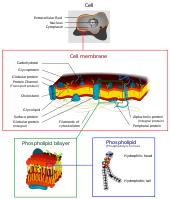
Photo from wikipedia
Single-walled carbon nanotube (SWCNT) transmembrane channel formation in a pure 1,2-dimyristoyl-sn-glycero-3-phosphorylcholine (DMPC) bilayer, and the spontaneous internalization of single-stranded DNA (ssDNA) into the formed pore were simulated. A combination of… Click to show full abstract
Single-walled carbon nanotube (SWCNT) transmembrane channel formation in a pure 1,2-dimyristoyl-sn-glycero-3-phosphorylcholine (DMPC) bilayer, and the spontaneous internalization of single-stranded DNA (ssDNA) into the formed pore were simulated. A combination of computational techniques, Dissipative Particle Dynamics-Monte Carlo hybrid simulations and quantum mechanical calculations at the hybrid-DFT level, was used as a new proposal to perform DPD simulations granting specific chemical identity to the model particles. The simulated transmembrane channels showed that, in the case of pristine SWCNTs and upon increasing the nanotube length, a higher tilt angle with respect to the bilayer normal is observed and more time is needed for the nanotube to stabilize. On the other hand, for SWCNTs with polar rims an almost perpendicular orientation is preferred with less than 15° of tilt with respect to the bilayer normal once the nanotubes have pierced both monolayers. These findings are supported by experimental observations where CNTs of average inner diameters of 1.51 ± 0.21 nm and lengths in the 5-15 nm range were inserted in DOPC membranes [J. Geng, et al., Nature, 2014, 514(7524), 612-615]. Moreover, the narrower the SWCNTs, the slower the spontaneous internalization of ssDNA becomes, and ssDNA ends hydrophobically trapped inside the artificial pore. A dependence on the nucleotide content is found indicating that the higher the presence of adenine and thymine in the ssDNA chains the slower the internalization becomes, in agreement with the experimental [A. M. Ababneh, et al., Biophys. J., 2003, 85(2), 1111-1127] and predicted solvation tendency in water for nucleic acid bases.
Journal Title: Soft matter
Year Published: 2020
Link to full text (if available)
Share on Social Media: Sign Up to like & get
recommendations!